The upsizing continues.
And for once, under the hood to go with it.
Kia’s new Telluride is much bigger than the mid-sized Sorento it replaces. But unlike most of its rivals, it doesn’t come with a smaller engine.
What It Is
The Telluride is Kia’s newest – and largest-ever – model.
It’s a three-row/eight-passenger crossover SUV that has a higher standard tow rating (5,000 lbs.) than any Kia made before it weighed.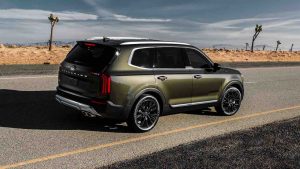
It’s also big in another important way.
A 3.8 liter V6 is standard in the Telluride – vs. the much smaller turbo fours that come standard in most of the current crop of plus-sized crossovers, including the VW Atlas – and which are the only available engines in large crossovers like the Subaru Ascent and Mazda CX-9.
And the Kia’s big six doesn’t use more gas.
It also has fewer parts than a turbocharged four and is less stressed than a turbocharged four that has to work harder to make the same power . . . which means it’s less likely that something’s going to break and there are fewer things to break.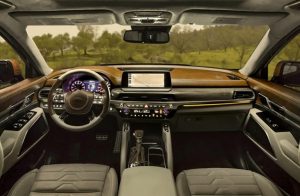
Ironically, the less-likely-to-break Telluride has the longest-running powertrain warranty of them all: Ten years or 100,000 miles.
Prices start at $31,690 for the base LX trim with front-wheel-drive; the same trim with the optional AWD system stickers for $33,690.
A top-of-the-line SX trim with AWD and the 3.8 V6 lists for $43,490.
What’s Good
Big – and strong – standard engine.
No upsell on the engine to get the AWD.
Exceptionally roomy (42.4 inches of legroom) second row.
What’s Not So Good
ASS (and various “assists”) are standard.
AWD comes standard – for less – in the Subaru Ascent.
VW Atlas has more cargo room.
Under The Hood
It’s getting hard to find a V6 in a crossover SUV – unless you pay extra for it. Which in most cases you’re forced to do – if you want AWD.
Assuming a V6 is even still available.
In the Telluride, it’s standard.
All trims get a 3.8 liter V6 (bigger than the 3.3 liter V6 that was optional in the Sorento) that makes 291 horsepower – substantially more horsepower than the turbo fours that are standard in rivals like the VW Atlas (2.0 liters, 235 hp) and all-you-can-get in the Mazda CX9 (2.5 liters, 227 hp) and Subaru Ascent (2.4 liters, 260 hp).
The Kia’s standard engine is also stronger than the VW’s optional 3.6 liter V6 (276 hp) which you have to buy if you want AWD – which isn’t offered with the standard four.
Also standard with the Kia – a 5,000 lb. tow rating.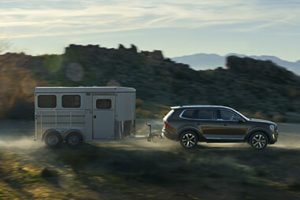
The four cylinder Atlas is a nice rig but it hasn’t got very broad shoulders as it comes; the standard tow rating is just 2,000 lbs.
You can upgrade that to 5,000 lbs. with the V6 – but you have to buy the V6, which raises the base price of the Atlas to $35,495 ($3,805 more than the price-to-start of the V6-equipped Kia).
Looked at another way:
You could take home a Telluride with AWD and still pay a couple thousand less than VW wants for the FWD V6 Atas.
And no matter how much you pay Mazda, the CX-9 is only rated to pull 3,500 lbs. – about the same as most current mid-sized cars.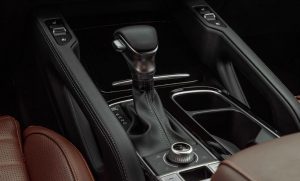
Among its direct cross-shops, only the Subaru Ascent matches the Telluride’s standard tow rating – and beats it by including AWD as standard equipment. However, the plus-sized Soobie comes only with a turbocharged four cylinder engine – which is a small engine for a vehicle this size.
The turbo boosts the power of the Ascent’s little four to V6-ish levels (and to be fair, the Soobie’s four makes more torque – 277 ft.-lbs. at 2,000 RPM vs. 262 ft.-lbs. at 5,200 for the Telluride’s V6. But it takes a turbo to do that.
More parts – and more pressure.
Not the hot ticket for longevity, usually.
Turbocharged engines used to be found almost exclusively in performance cars – as power-enhancers. They’re being used now to maintain power. To get a little four to make as much power as a larger V6 on demand – while getting higher gas mileage.
Except sometimes they don’t.
The V6/FWD Telluride is rated 20 city/26 highway by the EPA – exactly the same mileage as the 2.0-equipped Atlas and 2.5 liter-equipped CX9.
The 2.4 liter-equipped/AWD-standard Ascent does slightly better than the V6/AWD Telluride: 21 city, 27 highway vs. 19 city/24 highway. But it’s a hairsplitting difference. And it may be a less-than-advertised difference.
With a large engine, the advertised mileage is generally close to what-you-actually get mileage. But with a turbocharged engine, your actual mileage is often less-than-advertised – depending on how much (and how often) the engine is on boost.
Which will be often . . . if you expect to get V6-ish power out of it.
Mileage aside, the Telluride is also quicker as-it-comes than all of its immediate rivals. Zero to 60 happens in 7.1 seconds. The Atlas is quicker – but only if you buy it with its optional engine.
The Kia’s big V6 is designed for regular 87 octane gas, too.
Near-miracles have been performed with little engines, but why perform them? What is the advantage – to the person buying the vehicle – of an engine that’s harder working, has more parts and doesn’t deliver a meaningful mileage advantage?
Or even any advantage at all?
Including audible ones?
The Kia’s V6 produces a deep, Mustafa Mond bass note in the low and mid-ranges – the proper accompaniment for a big vehicle. The sounds made by fours are as out of place here as a salad at Peter Luger’s.
They’re not bad engines – just not appropriate engines for big SUVs. They’re only being used in big SUVs because of fuel-efficiency fatwas hurled by the government that are making it harder and harder to build big vehicles at all.
It’s refreshing to find a right-sized engine in the Telluride.
And it’s a tangible (and well as audible) advantage vs. rivals.
The Telluride’s optional AWD system is another advantage in that it is disconnectable (maybe not a legitimate word, but it gets the necessary point across).
In EcoSmart mode, 100 percent of the V6’s power goes to the front wheels; the rear wheels freewheel and this probably accounts at least partially for this big-engined Kia’s surprisingly good gas mileage relative to its small-engined rivals.
There are also Comfort/Snow, Smart and Sport modes that vary the power split from 80/20 front-to-rear to 65-35 front to rear (in Sport).
You can lock in a 50-50 split for maximum traction in snow or off-road.
The standard eight-speed automatic has two overdrive gears – eighth being a 0.648:1 ratio, which makes 25-plus MPG on average (what I averaged) possible even with a pretty aggressive 3.648:1 final drive ratio. Which gives the big T leverage down low for pulling and hauling.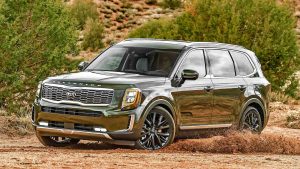
All trims get ASS – automated stop/start. This is becoming unavoidable in new vehicles regardless of type and for the same reason that so many big vehicles come with such small engines: To appease the government and its fuel efficiency (and C02 “emissions”) fatwas.
But there is an Off switch.
All trims come standard with 7.9 inches of ground clearance – but the T doesn’t drive like a jacked-up 4×4 SUV, which is a big part of the appeal of these big crossover SUVs. You feel like you’re driving something substantial – but also quiet and very comfortable.
Even on marginal roads, running a lot faster than most people ever will.
There’s an old country road I use to test the rebound damping of vehicles like this. The kind of road that makes axles hop – and fillings drop. If the Big T’s hopped, I couldn’t tell.
No need to slow down, even. Almost nothing was transmitted to the interior that suggested other than paved road. The effect was enhanced by the Kia’s superb seats; they’re not really buckets or benches but something in between.
Something exceptionally comfortable.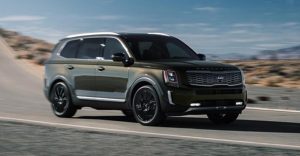
The Big T is also remarkably maneuverable. Its turning circle (38.8 feet) is only slighter wider than a Honda Accord’s (38.1 feet).
You sit up higher, of course – and that helps you to see better, too – but you see more because there’s less metal surrounding you and more glass. In most modern cars, you’re hunkered down – and the metal of the doors rises up while the glass pinches up and back. This makes electronic “safety assists” almost necessary to avoid pulling in front of someone or backing into someone.
The T has them, too – but they’re not necessary.
Because you can see where you’re pointing it – as well as what’s around it.
You might call it the TelluRover.
It’s a compliment.
The name is spelled out in widely spaced block lettering on the lip of the hood – just like you-know-who. But it looks as good here as it does there – and while there are similarities there are also differences that spell KIA, such as the inverted L (and L within the L) tail-lights and the eight micro-LED driving lights mounted below the smiley-KIA grille. The Telluride looks almost happy – which is a nice contrast to the angry design ethic that afflicts so many vehicles today.
Inside, there are also similarities . . . with Audis. Which isn’t a huge surprise given Kia’s styling chief, Peter Schreyer, is Audi’s former styling chief. He was – and is – known for styling that’s modern but ages well – no easy thing to pull off. He did the Audi TT and it still looks current even though it made its appearance way back in ’98.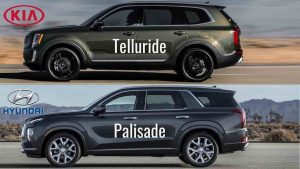
One other similarity is with the Hyundai Palisade – which is the same basic vehicle sold under the Hyundai label – and for a few hundred bucks less to start.
A big difference – vs. others in this class – s the allocation of interior room. The Telluride touts more second row legroom (42.4 inches) than first row legroom (41.4 inches) and its second row legroom is significantly more than in rivals like the Atlas (37.6 inches), Ascent (38.6 inches) and CX-9 (39.4 inches).
The third row is tighter – 31.4 inches – but that’s equally true about the third rows in all the vehicles in the Telluride’s class. They are big – but not enormous.
At 196.9 inches long overall, the Telluride is only about five inches longer than a mid-sized sedan such as the Honda Accord (192.2 inches). To get more third row legroom – and more third row access – you’ll need a minivan or a full-size SUV, neither of which has the turning circle of a mid-sized sedan.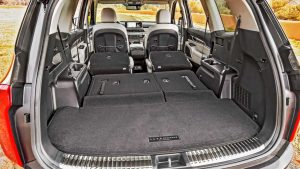
And besides, the Kia’s third row is adult-usable because it has almost as much headroom (38.1 inches) as the driver and front seat passenger enjoy (39.5 inches). This is because of the Kia’s sensibly flat rather than sloped roofline. Even with the optional see-through glass roof, six-footers can sit in the third row without slouching down to make some room for their heads.
Cargo capacity is 21 cubic feet with the third row up and 87 with the third row folded. This is about the same as you’d get in the Ascent (17.8 cubic feet with the third row up; 86.5 with the third row folded) a bit more than the Mazda CX-9 offers (14.4 and 71.2 cubic feet) and a less than in the Atlas, which cleans everyone’s clock with 96.8 cubic feet of total capacity.
The Rest
In addition to the V6, all Tellurides come standard with AppleCarPlay and Android Auto, five USB ports, an 8-inch LCD touchpad-style display for the audio and apps, adaptive cruise control and 18-inch wheels.
Many of these items aren’t included as standard equipment in rivals – especially the adaptive cruise control, which is often bundled with an extra-cost package or requires buying a higher trim.
Unfortunately, a number of driver “assists” are also standard, including Lane Keep Assist and Automated Emergency Braking. These are really driver-pre-emption/idiot-proofing technologies that are annoyances if you’re not an idiot and don’t like being pre-empted.
But, they’re much less peremptory than in several other models and you can turn them all off, just like ASS.
EX and LX trims offer a load-leveling suspension system to improve towing dynamics and a larger 10.3 inch touchscreen – plus a neat voice amplifier for the driver which lets you communicate with people way in the back without shouting.
There’s also a Quiet Mode for the audio system that cuts the feed to the speakers in back, if the people back there prefer not to listen.
The Bottom Line
It’s nice to see things get bigger – but not smaller.
. . .
Got a question about cars, Libertarian politics – or anything else? Click on the “ask Eric” link and send ’em in!
If you like what you’ve found here please consider supporting EPautos.
We depend on you to keep the wheels turning!
Our donate button is here.
If you prefer not to use PayPal, our mailing address is:
EPautos
721 Hummingbird Lane SE
Copper Hill, VA 24079
PS: Get an EPautos magnet (pictured below) in return for a $20 or more one-time donation or a $10 or more monthly recurring donation. (Please be sure to tell us you want a sticker – and also, provide an address, so we know where to mail the thing!)
My latest eBook is also available for your favorite price – free! Click here. 


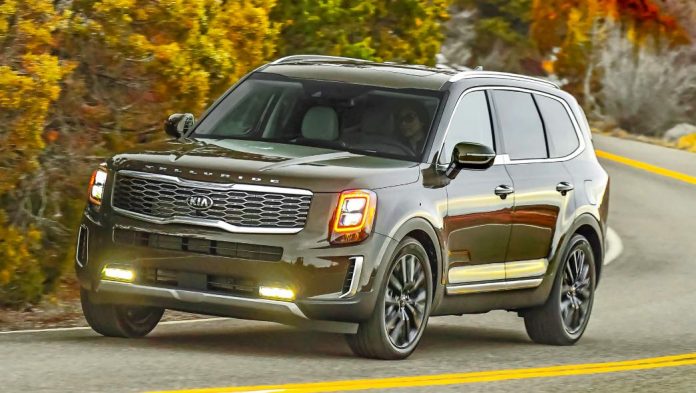


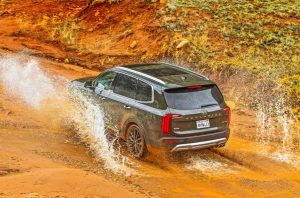

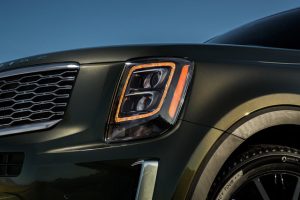








I test drove one of these this year. Aside from being a Kia, it seems like a great family car. It had tons of space inside and the second row can move up and back with a latch. I see a growing number of these in the Houston suburbs. It has a peppy engine in it but the AWD feels alien to me compared to RWD. It is affordable too which KIA aims for.
i like the price but im still leaning to the Honda Pilot especially since KIA has stiffed a bunch of owners with the carbon build up issue. They claim its a non warranty item. They desperately need duel injection
Two sets of injectors fighting each other ???
LOL – couldn’t resist!
Looks nice. Will beat up on the competition. But, it’s FWD based so basically it’s a minivan to me.
Ha! That’s what I thought it was when I first glimpsed the pic- a minivan. I thought it was a Caravan with a new grill…..
I agree. This is what sells though since no one wants a minivan…but they’ll buy a minivan w/o the nifty sliding doors and a little more ride height.
It’s all about that image. People are afraid of being shat upon for buying a practical car. It’s the same reason that everyone buys “smartphones” instead of cellphones with buttons. Everyone has to be like everyone else. Personally, the only thing I don’t like about minivans is that they are FWD. Yuck!
I don’t like the FWD, nor the “mini”…why not just have a van? The MPG difference is usually insignificant.
Yeah…..”smart-phones”- I have a <$30 Tracfone which I keep in the glove compartment, which gets turned on 2 or 3 times a year. It takes pictures, can receive texts (I don't do that though)…can play music- has 3 screens worth of icons for all sorts of things (I just want a stinking phone for the rare occasion when I need to make a call when I'm out)- so I don't get it- why would someone pay $600 or $1000 plus near $1000, plus monthly service….to do those same things? It's almost as if the "phone" part is an afterthought anymore…..
My phone has a calculator. I've never used it; I do four-figure with two decimal places xxxx.xx simple math in my head…. faster than it'd take me to pull out the phone (even if I carried it with me) and enter data.
Takes notes? Almost instantaneous with a pen and piece of paper/ And best of all, no one, other than myself and anyone else who may be within a few feet of me knows what I'm doing!
But smart-phones are probably the "hottest" most desirable and sought-after items of the last 100 years….People are crazy.
Front-wheel-drive? Ewww! Give me rear-wheel-drive, body-on-frame with a large straight-6, dammit!
Oh, who am I kidding? They’ve been “outlawed” years ago. Guess I’ll be driving my ’05 Trailblazer ’till the wheels fall off, then. lol
It’s hard to believe this is a Kia. They truly have come a long way.
How is the interior room vs. the Ford Explorer?
I note that the Kia is about 6 inches shorter overall.
What’s the deal with all of these modern vehicles having these humongous center consoles?! Do people want top be cramped-in there as if they had bought a Geo Metro? One day, someone’s gonna come out with a bench seat and no console, and it’s gonna be heralded as a revolutionary new concept……
Nunzio,
“What’s the deal with all of these modern vehicles having these humongous center consoles?! Do people want top be cramped-in there as if they had”
Just been put in a prison cell?
Heck, Tuan, with the “music” most people would have playing on the
stereo“info-tainment system” these days, I’m sure aurally, it sounds just like what one would hear in a prison!Right T. The car makers want you to see your new car as a prison on wheels. To reinforce the concept that bureaucraps are in charge of you.
Oversized child seats. All the airbags and other safety paraphernalia require the occupant to be in a very specific position to prevent injury. So you’re put in a seat that won’t allow movement. High backs to prevent whiplash. Side bolstering to keep you from sliding around. They sell it as a performance enhancer (seats like a formula 1 racer!), but the real reason is more akin to early photography rigs, keeping you in one position.
So now that everyone’s in their own seat, that makes for extra space. Might as well fill it with extra controls and cubbyholes. Maybe a few more charging ports too. And a large center console makes you keep your legs in one position too, so the knee airbags won’t break your legs when they deploy.
No wonder people fall asleep when driving.
Ding!ding!ding! Funny how the truth just jumps out at ya when ya hear it; and you’re speaking the truth, RK.
Look even at how the ginormous bulbous arm rests even play into it!
All these modern vehicles are so claustrophobia-inducing, how does anyone stand ’em?!
Instead of being “safe” by being strapped into a tight space so as to be a good target for the airbags, I prefer to be safe (and comfortable) by having lots of space around me, and only one airbag aimed at me (Which I never seem to get around to disabling…before it disables me!)
When they first came out with front-wheel drive, they touted it as freeing up so much interior space by getting rid of the driveshaft tunnel- and then immediately proceded to replace that tunnel with consoles that were literally ten times their size.
Then they’d ridicule the exterior styling of the cars from the 50’s, 60’s and 70’s and being too bulbous and bloated on the outside….and then they slimmed down the outside….and moved the bloat and bulbousness to the interior!
Sorry, but I do have to say here that I actually prefer tighter seats and belts. My old Sunbird had the most comfortable seats ever, like S-Class comfortable, but they had no freaking side support and so you basically had to hold yourself in the car by the steering wheel in hard corners.
Thing is, Chuck: We used to have a choice- so we could get what we personally prefer- We could get ’em with a bench or buckets; console; no console; etc.
Now, just as with everything else, it’s “Do as we say”- and of course, as RK pointed out, this is Uncle’s doing, for this is what’s needed to comply with the saaaaaaaafety mandates. (And if ya go on a man-date…ya know what happens to your rear-end!)
“What’s the deal with all of these modern vehicles having these humongous center consoles?!”
I’m assuming it’s there to fool the sheep into believing that they’re driving a RWD vehicle.
At least a part of Kis’a growing success can be attributed to their excellent exterior designs. Styling wise, I think this Telluride kind of lost it’s way.
It is not ugly by any means, but does not excel. I wonder how many Kia conquest sales resulted from their “tie breaker” good looks? This Telluride won’t have that advantage, but probably still will do OK.
“Telluride has the longest-running powertrain warranty of them all: Ten years or 100,000 miles.” (160,000km)
Unless you want to buy one in Canada. 5 year 60,000km (40,000 miles). Not even as good as much of the competition offers here.
https://www.kia.ca/kia-warranty?&sourceid=hp-dropdown
That is similar to warranty that the US commercial sale Kia get.
Kia can kiss my Canuck ass.
Correction, 5 year / 100,000km (60,000 miles) in Canada.
I’ve heard that Kia likes to deny warranty repairs. “Consumer protection” laws are usually much stricter in the Great White North, so maybe they have to actually honor the warranty there, so they have to be more realistic about the coverage. Eh? 🙂
That long powertrain warranty is a holdover from the days when Hyundai had to practically bribe people in the U.S. to buy their cars. (Kia is part of Hyundai.) When Hyundai first came to the U.S. in the 1980s their cars were miserable, maybe just a step above a Yugo, and quickly gained a terrible reputation. Kia was much the same when they arrived here as a separate company.
Rather than exit the U.S. market (as Fiat did in ’83) Hyundai dug in and improved their product over the years, introducing the long warranty to instill consumer confidence and entice customers. That warranty carried over to Kia when it was acquired. Over the years I’ve read of Hyundai considering cutting back on it, but that long warranty has become part of their image in the U.S. and they’ve stuck with it so far. I guess they didn’t see a need for a lengthy warranty in Canada. (Maybe Canadians were accustomed to low-quality imports from England and Eastern Europe and thus didn’t give Hyundai’s early faults a second thought. 🙂 )
I had a Kia bicycle once many years ago. It was OK.
My neighbor’s wife had a Kia in the early 00’s. She was so traumatized by it, that she goes off on a rant any time someone mentions Kia. Any time I hear “Kia”, I always picture her.
I drove an ’87 Hyundai Excel for a while. I have to say it started on the coldest of mornings, and other than replacing a CV axle, all I did was routine maintenance. Was it a “nice” car? Far from it, but it was perfect for a college student on a budget.
My BIL bought an early Excel too- I hated the dammed thing, but it served him well. I think quality control was hit or miss with Hyundai: In the very early 90’s, I went car shopping with an octogenarian; he looked at and test drove a Hyundai- brand new- and a dash access panel was open, and wires were bulging out…as they were in the process of fixing the darn thing…and it had like 10 miles on it! He ended up buying a Toyota Turdcell.
Nunz, the early Hyundais used recycled Mitsubishi technology from the 1970s which in theory should have been more or less OK for an economy car, but as you say quality control was really hit or miss. Mostly miss. I’m sure some worked out OK but overall they were pretty damned awful.
Yeah, Jason, I used to pick of enough of those things for junk- many were still perfectly functional….but just so rickety that no one wanted to drive ’em, or buy ’em….truly disposable cars.
I know of all my BIL’s cars over the years, the Excel was the one he had for the least amount of time (He used to keep his cars long- He had his ’73 Monte into the 90’s (Well…his daughter did at that point). These days he buys Hondas. I couldn’t believe that he bought the Hyundai- it was out of character for him.
Nice looking SUV except for those damn low profile tires 🙁